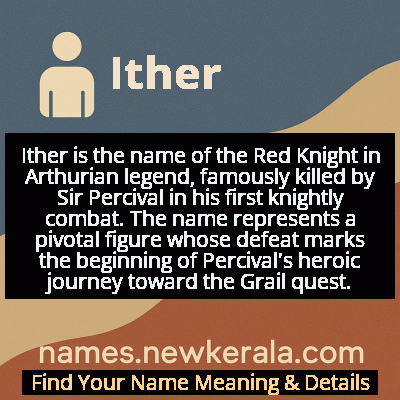Ither Name Meaning & Details
Origin, Popularity, Numerology Analysis & Name Meaning of Ither
Discover the origin, meaning, and cultural significance of the name ITHER. Delve into its historical roots and explore the lasting impact it has had on communities and traditions.
Name
Ither
Gender
Male
Origin
Arthurian
Lucky Number
6
Meaning of the Name - Ither
Ither is the name of the Red Knight in Arthurian legend, famously killed by Sir Percival in his first knightly combat. The name represents a pivotal figure whose defeat marks the beginning of Percival's heroic journey toward the Grail quest.
Ither - Complete Numerology Analysis
Your Numerology Number
Based on Pythagorean Numerology System
Ruling Planet
Venus
Positive Nature
Harmonious, responsible, caring, and artistic.
Negative Traits
Overly idealistic, superficial, possessive, or jealous.
Lucky Colours
Pink, turquoise.
Lucky Days
Friday.
Lucky Stones
Diamond, turquoise.
Harmony Numbers
2, 3, 9.
Best Suited Professions
Artists, musicians, teachers, healthcare workers.
What People Like About You
Warmth, nurturing nature, artistic flair.
Famous People Named Ither
Sir Ither of Gaheviez
Arthurian Knight
First major opponent defeated by Sir Percival in his knightly initiation
Ither von Gaheviez
Literary Character
Featured as the Red Knight in Wolfram von Eschenbach's Parzival epic
Ither the Red Knight
Mythological Figure
Guardian knight whose death marks Percival's entry into knighthood
Name Variations & International Equivalents
Click on blue names to explore their detailed meanings. Gray names with will be available soon.
Cultural & Historical Significance
The cultural significance of Ither extends beyond his individual character to represent the necessary sacrifices in heroic narratives. His death is not portrayed as villainous but as a tragic necessity in Percival's spiritual and martial education. This reflects the medieval understanding of chivalry as a path requiring both violence and redemption. In German Arthurian tradition particularly, Ither's role is more developed than in other versions, showing the cultural variations in how the Arthurian myths were adapted across Europe. His character continues to influence modern interpretations of the Percival story, maintaining his position as the gatekeeper figure whose defeat marks the hero's irreversible commitment to the knightly path.
Extended Personality Analysis
Ither's character, as depicted in Arthurian literature, suggests a knight of considerable pride and establishment. His willingness to confront the young Percival indicates confidence in his martial abilities and perhaps a certain arrogance born of his royal connections as Uther Pendragon's nephew. The epithet 'Red Knight' and his distinctive armor suggest a flamboyant personality who understands the symbolic power of appearance in medieval chivalry. His territorial protection of Kukumerlant shows a sense of duty and responsibility, while his ultimate defeat reveals the vulnerability beneath the knightly facade.
Contemporary analysis of Ither's character often focuses on his role as a sacrificial figure rather than a villain. His personality embodies the established order that must be challenged for growth to occur, representing the institutional knighthood that Percival must both join and transcend. The tragedy of his death suggests a complex character who, while confident in his position, becomes collateral damage in the larger narrative of Percival's destiny. This complexity makes him more than a simple antagonist, but rather a representation of the costs inherent in the chivalric system and the inevitable passing of one generation's heroes to make way for the next.
Modern Usage & Popularity
In contemporary times, the name Ither remains almost exclusively within the realm of Arthurian scholarship and specialized literary use. It has never achieved mainstream popularity as a given name, likely due to its strong association with a character who meets a violent end and its distinctly medieval, literary quality. The name occasionally appears in fantasy literature, role-playing games, and Arthurian adaptations as a reference to the original character, but practical usage as a personal name is virtually nonexistent. Among Arthurian enthusiasts and historical recreationists, the name might be used in character contexts, but it lacks the romantic appeal of other Arthurian names like Lancelot or Tristan that have seen occasional modern revival.
Symbolic & Spiritual Meanings
Ither symbolizes the threshold guardian archetype in heroic mythology, representing the established order that must be overcome for transformation to occur. His red armor carries multiple symbolic meanings: the blood of sacrifice necessary for spiritual growth, the passion and violence of knighthood, and the earthly power that must be transcended in the Grail quest. As Uther Pendragon's nephew, he also represents the dynastic and institutional aspects of kingship that Percival must both honor and move beyond in his spiritual journey. His death at Percival's hands symbolizes the necessary violence in the transition from innocence to experience, and the cost of achieving one's destiny in the Arthurian world.

